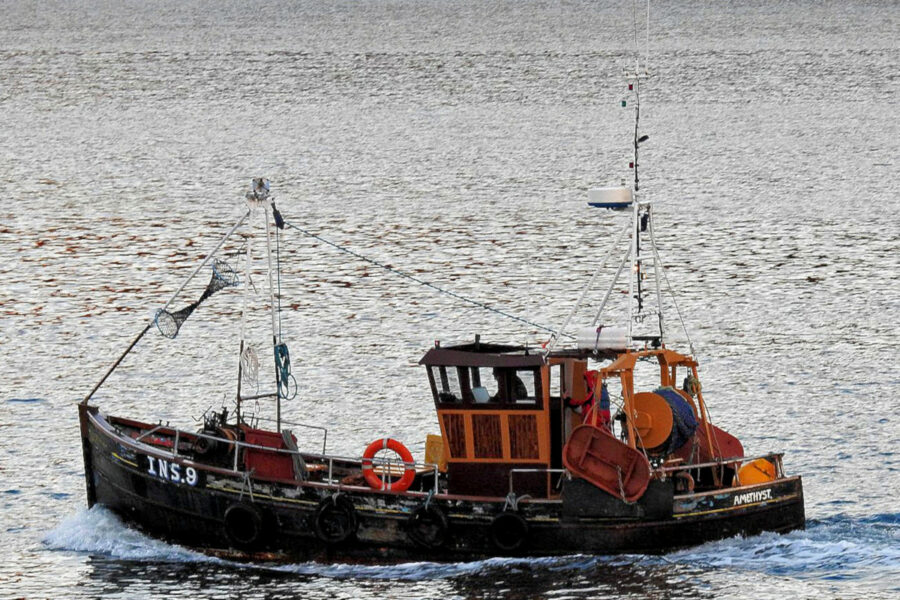Built in 1960 at the Fraserburgh boatyard of T Summers & Co, the traditional Fraserburgh yawl Amethyst has recently been lovingly refurbished at Lochaline, reports David Linkie
Nearly three years ago, Malcolm Burge and Kay Nuttall fulfilled a long-cherished ambition of owning a traditional Scottish wooden-hulled fishing boat, when they bought the Fraserburgh yawl Amethyst INS 9.
As well as meeting their main requirement of Scottish provenance, Amethyst ticked several more boxes for its new owners by having been built at the renowned Tommy Summers boatyard in Fraserburgh.

Amethyst as delivered by Tommy Summers & Co in 1960.
Thirty-one distinctive Fraserburgh yawls were launched from the Summers boatyard at Fraserburgh, which was located at a site on Steamboat Quay midway along the north breakwater, where a number of pelagic net stores are situated today. It is interesting to note that one of the net stores now owned by Lunar Ltd lies in the same area where the Peterhead family’s first boat, the 74ft herring drifter Lunar Bow PD 425, was built in 1954.
Amethyst FR 321 was built in 1960 for Fraserburgh skipper Andrew Noble, and was the 23rd yawl to be launched by T Summers & Co.
Traditionally constructed of larch planking on oak frames with a pitch pine deck, Amethyst had main dimensions of LOA 9.48m, beam 3.5m and depth 1.55m. Primarily designed for ripper and line fishing, Amethyst was powered by a Gardner 3LW (39kW) engine coupled to a Gardner 2UC gearbox of 2:1 reduction.
A mechanically driven capstan was located forward of the wheelhouse, on a raised steel casing positioned over the engineroom to give more internal clearance. Two bunks were fitted in the accommodation cabin forward of the fish hold amidships.
Other characteristic yawl features included lift-out deck hatches either side of the wheelhouse doors, thereby extending the width of the lowered floor in the wheelhouse, chain steering, a single mast forward that could be lowered to sit on the wheelhouse, 24v electrics, and a Kelvin Hughes paper sounder.
Some nine years after being built at Fraserburgh, Amethyst moved south to Berwick, after being bought by local skipper Ted Lough, primarily to fish creels in Goswick Bay.
After fishing from the Tweed Dock for nearly 15 years, during which time a hydraulic slave hauler was fitted forward, Amethyst was sold to Maryport at the start of a series of moves that included Oban, Killybegs and finally Burghead.
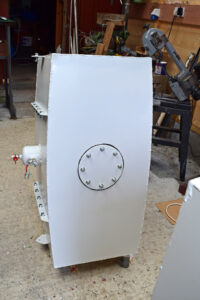
One of the new wing fuel tanks that Malcolm Burge fabricated.
When Malcolm Burge and Kay Nuttall left Burghead astern for Inverness and the Caledonian Canal, en route to Lochaline, the vessel’s centreline machinery was still the same as that installed 56 years earlier – although Amethyst’s profile had changed considerably over the past 25 years, during which time a new wheelhouse and forward mast had been fitted, in addition to a trawl winch and net drum.
Understandably, although it was running reliably, the engine was not performing at its best, and was emitting a cloud of smoke as Amethyst headed west at a top speed of five knots, which was not ideal passing under Kessock Bridge against the customary strong ebb tide.
On entering the Caledonian Canal, Amethyst immediately filled each successive lock basin with diesel fumes, much to the annoyance of the hire boats in the basins at the same time.
After four days endured in a cold and leaky cabin, Malcolm and Kay eventually reached Lochaline, during which time, despite the smoke and fumes, the Gardner engine never missed a beat.
On completion of further remedial work, Amethyst left Lochaline for its first fishing trip. Shortly after the trawl was in the water, Amethyst rolled in the wake of a passing ferry, and the engine stopped.
“The new tanks hold 225 litres each, providing the same total as the three original tanks”
This was correctly identified as a fuel blockage, and was resolved by disconnecting a pipe and blowing up it to the tank until bubbles were heard, when the engine was restarted with the last kick of the battery. However, at this point the owners took the decision to do a proper job on all of the mechanical problems.
What proved to be a 30-month rebuild programme began in August 2016, when two new fuel tanks were fabricated to replace the converted Calor gas cylinders previously positioned each side of the engine. At the same time, an old air receiver across the stern, which held fuel but blocked any access to the steering gear, was removed.
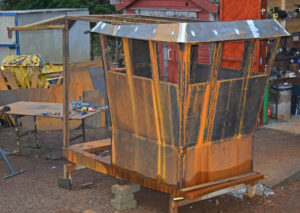
Fabricating the new wheelhouse…
The new tanks hold 225 litres each, providing the same total as the three original tanks. Connected to fillers and breathers that are located in the coaming at the foreside of the wheelhouse, each tank is slightly curved top and bottom so that any water or sludge will settle in the sump welded to the bottom of each tank.
Work then started to replace the original timber engineroom coaming, which was in a poor state, with a new steel one with removable deck panels and centre beam. This arrangement left a large open access to fit or remove the engine and fuel tanks.
It also meant that the planned new wheelhouse would bolt to the coaming, so that it could be removed if necessary.
The new wheelhouse was fabricated from steel, but made to be as light as possible. Frame panels were made from 3 x 30mm angle-clad, with 2mm sheet.
On completion of the wheelhouse plating, work started on a new aft gantry.
Designed to support the net drum and give room to work at the stern, the gantry was braced back to the wheelhouse roof, where it would bolt to brackets welded to the wheelhouse frame.

… and silencer.
The original net drum was retained and mounted in bearings on the gantry. As the net drum previously turned too quickly, Malcolm Burge fabricated a 2:1 chain reduction from the hydraulic motor. This also meant that the motor did not stick out too far over the side deck.
In order to reduce the level of noise from the previous loud wet exhaust, the decision was made to go for a dry exhaust with a silencer. This was fabricated out of 2mm steel with a perforated tube inside, then packed with rockwool. This subsequently proved to be a correct decision, as now only a gentle Gardner purr is heard by anyone standing close enough to the fully rebuilt engine.
“In order to reduce the level of noise from the previous loud wet exhaust, the decision was made to go for a dry exhaust with a silencer”
Some six months into the extensive refurbishment project, support steel was welded inside the wheelhouse to stiffen the front and side panels, along with giving support for the steering and console.
The wheelhouse was cleaned and primed, then coated with thick black sealer to guard against rust, before 25mm Jablite insulation was glued between the frame angles. The roof was then lined on the inside with 5mm ply which had fabric headlining glued to it, and held in place with screws and cup washers into the steel frame.
The lower part of the wheelhouse was lined with 9mm marine ply, onto some of which teak veneer was glued. Removable panels give access to fuse boxes and wiring.
The door was constructed from a timber frame, clad both sides with plywood and insulated inside. It was then clad on the outside with thin purple heart timber strips, to make it look like a hardwood door. Also, it does not swell, shrink or stick.
The window frames, and all the wheelhouse edging, were made out of recycled Australian hardwood that came from the floor of an old police gym, kindly donated by a pal. Ronseal exterior gloss stain was used in preference to yacht varnish, as from previous experience, Malcolm Burge has found this easy to recoat, without having to deal with peeling yacht varnish.
With the anticipated onset of better weather by May, thoughts turned to lifting out the Gardner engine in preparation for a total rebuild.

A 2:1 chain reduction was constructed to reduce the speed of the net drum.
This was achieved smoothly with the help of Malcolm and Kay’s good friends from the nearby mine, who arrived on the quayside with a forklift that accomplished the task with consummate ease, before the wheelhouse quickly followed suit.
When the 42hp three-cylinder engine was lifted clear of the engine beds, the boat came up a foot, illustrating the quality and weight of the unit, and going a long way towards explaining why it had given 56 years of sterling service.
After being lifted ashore, the engine was taken straight to the mine workshop to be pressure-cleaned, before being delivered to Malcolm’s workshop at his house.
Before Malcolm got to grips with the engine rebuild, the owners tackled the unenviable task of cleaning out the bilges, which they had no hesitation in describing as the worst part of the vessel’s refurbishment.
The engineroom deck planks were burnt at the same time as the steel engine bearers were removed for refurbishing.
The old fuel tanks were removed and scrapped, along with any fuel pipes.
A labour-intensive week of filling bags with oily sludge and scrubbing down with strong detergent ended with the satisfaction of seeing that the frames were in great condition.
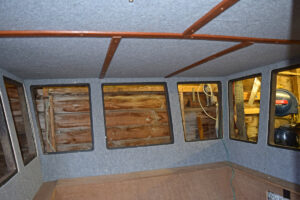
Lined upper half of the new wheelhouse…
When the new coaming was fitted, Kay started to paint the engineroom from the keel to the deckhead, while Malcolm stripped down the Gardner engine.
Being a highly experienced and skilled engineer, Malcolm quickly realised that the engine needed more than a clean-up.
The cylinder head was choked, and the valves were shot. The exhaust manifold was badly corroded, along with the injectors and leaking pipes. Springs were broken and bearings were worn in the gearbox. All in all, it was a miracle that it ran at all.
The saving grace for the engine was that the oil pressure and the main and big end bearings were perfect after 56 years of use.
Another factor to consider was that Amethyst’s fishing licence was for 42hp. Discarding the original engine and replacing it with a more powerful unit would require considerable expenditure on licence kilowatts.
Having considered the various options, it was decided to rebuild the engine – a decision helped by the sentimental thought that Amethyst would still be using the same engine that was fitted in Fraserburgh in 1960.
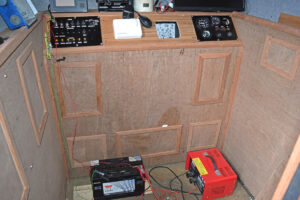
… in which panels were incorporated into the lower sections.
Many engine parts were replaced during the rebuild, which involved phoning countless people to track bits down. The brand new cylinder head came from an advert on FAFB, gearbox springs from a guy in Ireland, cams and exhaust manifold from eBay, rocker cover and valves from Stockton. Many other parts were sourced by word of mouth or recommendation.
An old automotive flywheel sourced from Mull eventually yielded the starter ring to replace the badly worn original – but only after a long day in which Malcolm and a friend used two gas weedkillers and a lot of heat before successfully managing to remove the required part.
By October, Kay had removed every scrap of paint from the engineroom. This was then painted with white acrylic paint which, being water-soluble, worked well in the damp atmosphere.
As soon as the engineroom was repainted, the new fuel tanks and refurbished engine bearers were fitted. The exterior of the new wheelhouse was also painted, as plans were put in place to move the refurbishment project on before the onset of winter.
After Amethyst was towed alongside the Old Pier at Lochaline, the friendly mine team again used a forklift to move a pristine-looking engine down from Malcolm’s workshop, before it was carefully lowered onto the beds.
When the bridge and deck panels were bolted down, the equally pristine new wheelhouse was lowered onto the coaming and bolted down. Completion of these major developments was deservedly marked by a wee celebration in the social club on the other side of the quay.
Work resumed the following morning, when a new exhaust pipe was fabricated and bound with heatproof bandage.
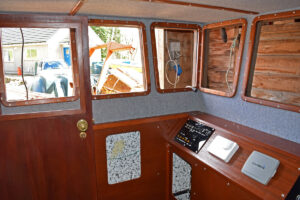
Wooden window frames fitted.
The focus now turned to completing the superstructure. The stainless steel tube that made up part of the original gantry was cut up and recycled into the top part of the new aft gantry. The centre post of this structure, which is also designed for lifting ground rope hoppers, hinges down to give easy access to lights, radar and aerials.
A new hydraulic tank was fitted near the fore end of the engine. The old hydraulic pump and clutch were replaced with new ones mounted on the modified engine bearers.
All-new hydraulic hoses were fitted, along with a changeover valve in the wheelhouse, to divert power from the winch to the net drum. A pressure relief valve was also fitted as a safety device.
The hydraulic installation was completed by fitting a new net drum drive motor and valve, which all worked well from the off.
Two years after arriving at Lochaline and after lining up the engine, fitting a new foremast and pulling on the fishing gear, an extensively rebuilt Amethyst was ready for trials.
On a perfect day in Loch Linnhe, everything worked well and the engine ran like a watch.

Lifting the old wheelhouse…
Malcolm Burge reported that Amethyst can do seven knots at 950rpm, and uses just 4.5 litres of fuel an hour. There is not a puff of smoke, neither does she use any oil.
Amethyst is still a work in progress. New bulwark planking is scheduled to be fitted next, followed by a good paint job and new coping irons.
Amethyst is still licensed with an MCA certificate, everything mechanical works, and it can still tow a trawl. That is a fitting tribute to T Summers & Co, which built the vessel 59 years ago, as well as to the unstinting expertise and TLC that Malcolm Burge and Kay Nuttall, and many good friends, have provided since August 2016.
Amethyst project proves to be ‘a bit special’
“Refurbishing Amethyst has turned out to be a bit special, not because of what it is, but for the contacts and friends we have made as the rebuild has progressed,” said Malcolm Burge.
“I always wanted to own a traditional Scottish fishing boat, from the time I saw Janet FR 168 when it arrived in Rye (Sussex) – when I thought, I want one of those.
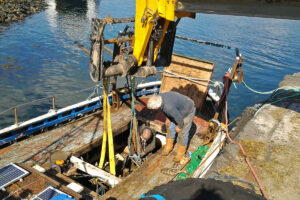
… and Gardner engine ashore.
“In 2016, after we retired, there was an opportunity to buy Amethyst. Knowing that there would be loads of work involved, but quietly confident that Kay and I could get it back to reliable working order, we purchased it.
“Over the years we have built and rebuilt several boats, so we had a pretty good idea what would be involved.
“The lads at the local mine have been brilliant with their help, not to mention over 400 people following progress on Facebook.
“Fraserburgh skipper Alexander West got in touch through a common interest from his great-grandfather and grandfather having jointly owned a Tommy Summers yawl called Gracious FR 168.
“We immediately struck up a friendship, and jointly manage the Tommy Summers Facebook page.
“So really, it has developed from a retirement project into a way of life.
“In a nutshell, it sure as hell beats bingo and ballroom dancing!”
Ripper fishing

Cleaning the engineroom bilge.
Rippering for cod from small boats on the extensive hard bottom between Kinnaird and Rattray Head will forever be a proud part of Fraserburgh’s fishing heritage.
While the large fleet of distinctive ripper yawls, that used to berth six/seven abreast in the Balaclava harbour, have been replaced today by a modern fleet of twin-rig prawn trawlers, in previous generations Fraserburgh yawls played an important role in the local community, especially during their heyday in the 1950s and 1960s.
Traditional inshore ripping was carried out by a crewman using a sisal handline attached to a narrow cone-shaped lead weight called a sproule. Sproules usually weighed about 2-2½lb (1kg) and were 10-12in long. A slightly longer length of steel bar was inserted into the wider bottom end of the sproule when the molten lead was poured into a homemade mould. Bent into a characteristic slight curve, depending on personal preference, this was used to attach a single lead ripper using a short snood about one fathom long.
The design of a traditional Fraserburgh cod ripper, which still proves effective today and has not changed in over 50 years, is based on simplicity, usually about 5in long and of relatively fine rectangular cross-section. Two sets of parallel hooks are inserted through holes arranged at 90° to each other in the lower section of the ripper. Originally size 5 hooks were used, before being replaced with 15s.
In the early days of rippering, snoods were made from cat gut. As material technology advanced, cat gut was replaced by the use of two similar lengths of 60lb nylon, twisted together to create the desired snood strength. In the 1960s, this was gradually replaced by 120lb monofilament, initially sourced from Faroese longliners.
The increasing availability of heavy monofilament resulted in ripper men starting to use three or four feathered hooks on a slightly longer snood between the sproule and ripper.
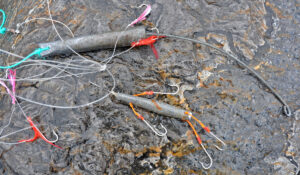
A typical set of Fraserburgh ripper gear, including the characteristic sproule.
This increased fishing efficiency, with cod sometimes going for the feathers, although rippers continued to take most fish. When cod were feeding, yawl men say that it was not unusual to haul up to find two to three fish on the feathers, and another two on the ripper. In fishing down to 15-30 fathoms and hauling by hand, rippering, like any other form of fishing before the introduction of hydraulics, was manually intensive.
Apart from the proximity of the hard ground favoured by cod, one of the key factors for a successful ripper fishery off Fraserburgh was that there are no major rivers in the area. This meant that water clarity, essential for rippering, was seldom less than suitable.
Cod rippering using small inshore boats fitted with sails/oars was carried out from the nearby smaller harbours at Cairnbulg, Sandhaven and Rosehearty, as well as Fraserburgh.
The consistent catches of cod, known locally as keilan (originating from keila, the Norwegian word for cod), which were sold in the country by the fishermen’s wives, led to a new design of decked vessels – the distinctive Fraserburgh yawls – being developed by three men, Tommy Summers, George McLeman and Bill Mitchell, who established a new boatbuilding company on the north breakwater.
Fraserburgh Yawls

Fraserburgh yawls berthed in the Balaclava basin in the early 1960s.
Between 1949 and 1962, when a lack of orders forced the company to cease trading, Tommy Summers & Co built 91 wooden-hulled fishing boats, ranging in LOA from 31ft to 97ft. Some of these boats were constructed on the opposite side of the Balaclava basin, after Summers took over the Wilson Noble boatyard in 1959.
Generally between 30ft and 34ft LOA, these cruiser-sterned small-engined vessels, which started to replace the 100-year-old Fifie style, immediately proved to be ideally suited for ripper fishing. As a result, Tommy Summers received orders for a succession of very similar ripper yawls after George Duthie of Sandhaven took delivery of the first, Fisher Boys FR 54, in 1949.
In subsequent years in the 1950s and 1960s, three or four Fraserburgh yawls, typically costing approximately £2,500, were often at various stages of construction at the same time. Credited with building 31 yawls, the Tommy Summers boatyard was the most productive builder of ripper boats.
Consisting of nearly 40 boats, the Fraserburgh yawl fleet was at its peak in the mid-1960s, before numbers started to dwindle from 1970 onwards, when some boats started to be sold to other ports.
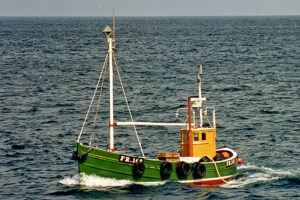
Skipper Zander West’s yawl Gracious returning to Fraserburgh harbour in the late 1980s. Gracious was built at the Summers yard in 1957.
Initially yawls were fitted with small engines, typically 22/33hp Kelvin petrol/paraffin units, the slow idling speed of which was good for rippering, when it was essential not to drift too quickly over the ground. Skippers achieved this by running slow astern into the tide with the rudder hard over, when the low revs allowed the engine to be kept in gear for extended periods. In addition to Kelvins, yawls also used Russell Newby, Bolinder and Gardner engines.
Removable rectangular deck hatches on either side of the wheelhouse, leading to the recessed floor of the low-profile wheelhouses, which incorporated port and starboard doors, were another characteristic feature of Fraserburgh yawls. This arrangement enabled a skipper to manoeuvre the vessel while continuing to fish his ripper line.
When conditions suited, ripper yawls often left Fraserburgh shortly before daylight to fish the flood tide down towards Rattray, before returning north on the ebb. Other popular grounds that were fished included the Rosehearty shoal west of Sandhaven and the west shoal, seven miles northeast of Fraserburgh, where skippers can remember some 20 boats fishing in the same area. The development of Decca plotters subsequently enabled ripper skippers to open up new grounds further offshore, like the Buchan Deeps.
Crewed by two or three men, a ripper yawl would typically return to Fraserburgh harbour to land five or six boxes of cod for the late afternoon sale, after being at sea for 10-12 hours.
The spring months usually yielded the best catches of cod when rippering. Most yawls worked mackerel feathers during the summer, although some crews also diversified to lobster creels. Mussel-baited small lines were generally worked during the winter.

